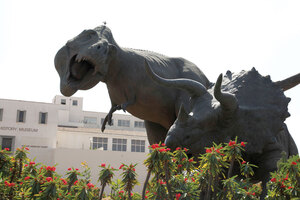Museum hopes to increase student awareness
Few students have noticed the world-class institution sitting right across the street.
Even fewer realize it’s free.
Located across the street from USC in Exposition Park, the Natural History Museum of Los Angeles County boasts more than 35 million specimens, some of which are as much as 4.5 million years old. The museum includes an array of exhibits displaying dinosaurs, African mammals, insects, birds and various elements of California’s history.

We’re back · Sculptures of dinosaurs appear to do battle outside the Natural History Museum of Los Angeles County in Exposition Park, across the street from USC. The museum is attempting to expand its relationship with USC students and faculty. - Mike Lee | Daily Trojan
But, despite an exclusive discount offering free admission to USC students, awareness of the museum on campus is still relatively low.
“Word is slowly getting out. We are beginning to get more calls from professors and we are still making calls,” said Su Oh, director of education at the museum. “You don’t have to jump into a car to go, students just have to walk across the street.”
But many students said they didn’t know about the museum.
Beyond just the exhibits, the museum offers programs including “First Fridays,” a nighttime event that transforms the museum to accommodate a band, a DJ, food and drinks. Michael Quick, executive vice dean for the College of Arts and Sciences, moderates the “First Fridays.”
“They approached me and I thought it was a great opportunity. We are right across the street, we do a lot of science so it seems natural to be a part of this,” Quick said.
Though entrance to “First Fridays” is also free to students, Oh said few have taken advantage of the opportunity.
“Ironically more people who have to pay attend the event even though USC students get in for free,” Oh said. “It gets tough, students get caught up with their work but the museum can be fun.”
The museum facilitates program lectures, allows researchers to work with professors — some scientists are also be adjunct faculty — and partners with The College Commons to sponsor lectures.
Oh said the museum is trying to enhance its awareness on campus, especially about opportunities it offers to the faculty.
“I think there can be a long-term collaboration that can support students and create outside-the-box events. Currently we have individual people with individual ideas,” she said. “If we have their faculty and our faculty involved it can lead to courses, field trips, internships — creating more opportunities for students.”
The museum also offers opportunities directly for students, like internships, volunteer work, research opportunities and work-study positions.
Some students feel having the opportunity to use their work-study at the museum creates a different experience.
“It’s nice to get off campus for a while, it feels more like a real job,” said Joel Kropinski, a junior majoring in cinema-television critical studies, who works at the museum’s marketing and communication office. “The museum is an important part of the community and I’m glad to be a part of it.”
The museum also has a few USC graduate students who, as part to their dissertation research, work closely with the curators at the museum. As “graduate students in residence at the museum,” they are provided with office space and other resources including access to the collections they need for their research.
Jack Tseng, one of the graduate students in residence, said working at the museum has been an integral part of his graduate work at USC.
“Many of the paleontologists at the museum are very famous, not to mention they do excellent work, and that was part of the attraction for me to conduct my graduate study at USC,” Tseng, a doctoral candidate in the integrative and evolutionary biology program, wrote in an email.
Tseng further emphasized how valuable the museum resources are.
“Evolutionary biologists come from all over the world to visit the Natural History Museum of Los Angeles County for its research specimens, and we have everything right in our backyard,” Tseng said.
The proximity of the museum to USC also allows some curators to continue their education.
James Dines, a collections manager at the museum, is currently attending USC and working on his Ph.D. in integrative evolutionary biology.
“It’s a unique arrangement since we’re right across the street from each other,” Dines said. “There is actually a long standing of curators who are also adjunct faculty and some staff workers at the museum are also obtaining their degrees at USC.”
Dines said he hopes students realize the museum can be used as a resource to emphasize what they learn in class.
“It’s not just a museum you go to when you’re a kid, there [are] a lot of interesting things that go on outside of what students learn in class,” Dines said.
Many students said they were interested, but don’t always have enough time.
“It’s not high on my priority list,” Cynthia Lee, a sophomore majoring in computer engineering and computer science. “But it is something I want to do before I graduate.”
Quick acknowledged that students might not have time, but pointed out if they don’t take advantage of the opportunity now, they might not get to it later.
“People are busy, and since it’s in your backyard you feel like you will do it eventually but you never do,” Quick said. “If they feel it’s boring, after attending some events they may change their mind.”
